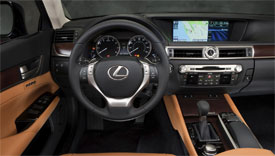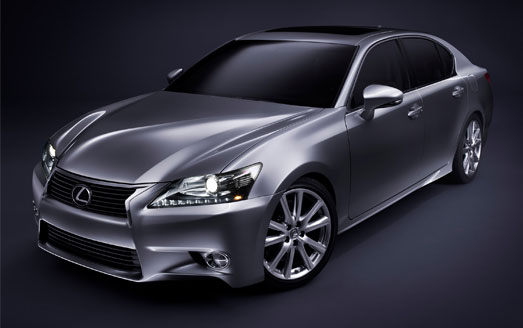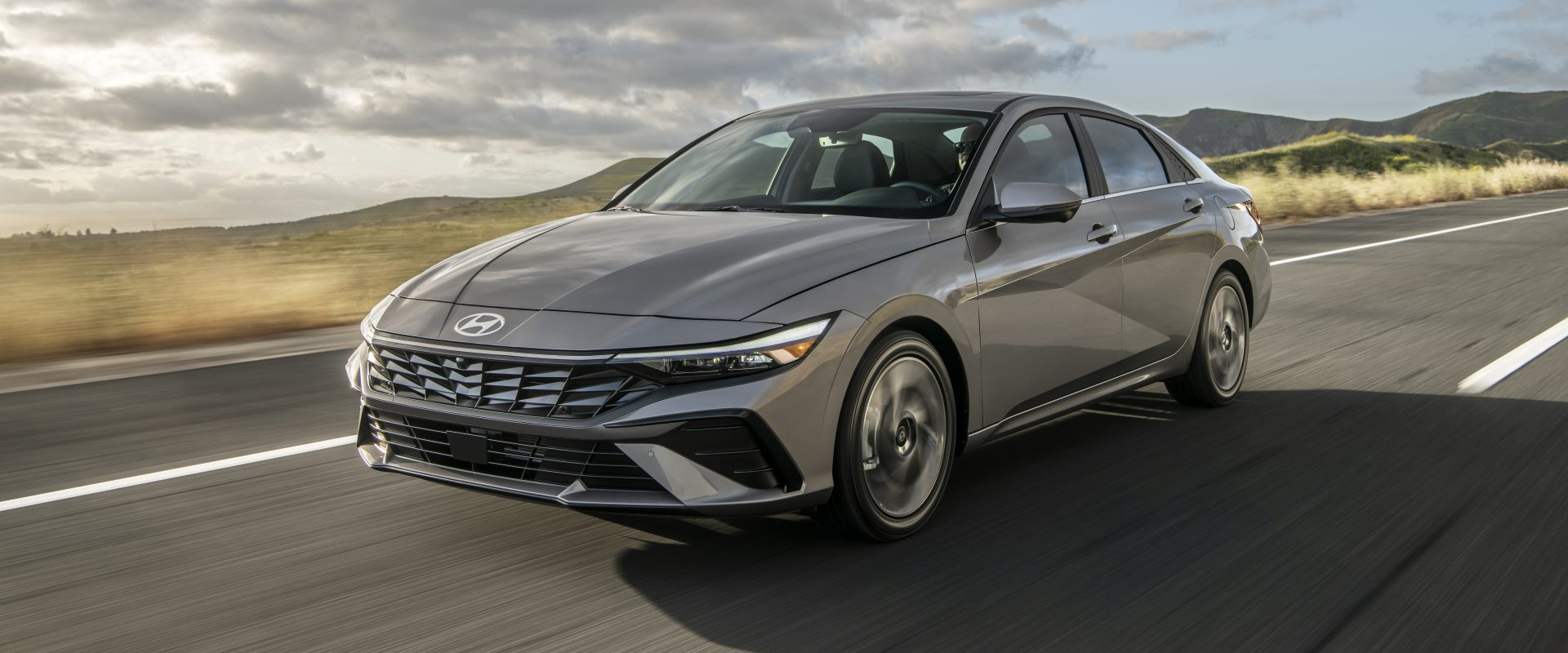2013 Lexus GS 350
Lexus is on a mission, to shed their image of building cars that are very luxurious and high tech, but boring to drive. First came the compact IS-F, than the exotic LFA, and now they’re turning their attention to a car with wider appeal, the mid-size GS sport sedan. So, is the latest GS a Lexus reborn?
With the fourth generation 2013 GS 350, Lexus does appear to break from their luxury-overload mold. Not that the rear drive GS has been a snoozer. Truth be told, the previous GS was already fast, and more entertaining to drive than most people gave it credit for. The biggest problem was electronic, with one of the most aggressive and intrusive stability control systems on the market that quickly kept you from having any real fun. So, the fix was more of a software one than hardware. Not that the hardware hasn’t changed.
 The 2013’s body and chassis are all-new. And, the sheet metal is undeniably more aggressive… at least from the front, with huge air intakes that widen towards the pavement, menacing HID headlights with LED running lights, and LFA inspired curves. In profile, the look is more familiar, with smooth sides and thick C-pillars, leading to a rear end that is tall with a trunk-lip spoiler, L-shaped tail lamps with lens mounted fins, and an aggressive lower fascia with integrated dual exhausts.
The 2013’s body and chassis are all-new. And, the sheet metal is undeniably more aggressive… at least from the front, with huge air intakes that widen towards the pavement, menacing HID headlights with LED running lights, and LFA inspired curves. In profile, the look is more familiar, with smooth sides and thick C-pillars, leading to a rear end that is tall with a trunk-lip spoiler, L-shaped tail lamps with lens mounted fins, and an aggressive lower fascia with integrated dual exhausts.
Feeding those pipes is a slightly revised 3.5-liter V6. Horsepower and torque are up marginally, to 306-horsepower and 277 pound feet; Lexus puts 0-60 at 5.7 seconds. There are no plans for a V8, but engineers added an Intake Sound Generator that sounds like one. The GS 450h Hybrid will boast 338-horsepower. A revised, paddle-shift 6-speed automatic is standard. New is drive-mode selector with ECO, Sport, and Sport Plus settings. All wheel drive is once again an option.
With all this, plus endless Lexus hype, we knew the GS would outperform its predecessor. But, on our first drive even we jaded journalists were impressed with the improved handling. This new found prowess still relies heavily on electronics however, mainly a new Adaptive Variable Suspension. To that, add Electric Power Steering, Dynamic Handling with Variable Gear Ratio Steering, Dynamic Rear Steering, and Vehicle Dynamics Integrated Management.
But, the most important difference for the new GS, is genuine feel and feedback, which in itself is game changing. Sure, even with the upgraded F-Sport Package, there are times when the car’s handling is not telegraphic, but also in un-Lexus-like fashion, you can turn all the electronic traction nannies off!
Looking around the inside of the new GS, its still classic Lexus, but with a nod to the best from BMW. High end leather abounds, with contrasting stitching on the dash. The wood and leather wheel features many controls, and can be heated. The Lexus remote touch central controller still manages most functions, but it now has a more convenient push-to-enter design. The optional nav system grows a hooded center screen from 8 to 12 inches. And, for as big as it is, it never seemed intrusive. Voice activation is included.
 Gauges look 3-D with lighting that changes from ECO Blue to Angry Red in Sport Mode. Our GS Luxury was equipped with just about every amenity you could imagine, head-up display, blind spot monitoring, night vision, window shades all around, and comfortable, heated-and-cooled, 18-way power adjustable front seats. Even rear seat occupants get coddled with flip down armrest controls for heated seats, climate, and audio. Leg room is up thanks to redesigned front seats. The trunk is also roomier, due to a more compact rear suspension. Capacity is up to 14.3-cubic feet.
Gauges look 3-D with lighting that changes from ECO Blue to Angry Red in Sport Mode. Our GS Luxury was equipped with just about every amenity you could imagine, head-up display, blind spot monitoring, night vision, window shades all around, and comfortable, heated-and-cooled, 18-way power adjustable front seats. Even rear seat occupants get coddled with flip down armrest controls for heated seats, climate, and audio. Leg room is up thanks to redesigned front seats. The trunk is also roomier, due to a more compact rear suspension. Capacity is up to 14.3-cubic feet.
Government Fuel Economy Ratings haven’t been released yet, but estimates are 19-City and 23-Highway on Premium. Nor is pricing set, but when sales start in February, expect the GS 350 sticker to start about where it does now, near $48,000.
While the 2013 Lexus GS 350 is undeniably more capable and fun to drive, it still falls short of providing the absolute feedback of European and even American rivals. The F-Sport model is more serious; but outside of wheels, tires, and brakes even it relies mostly on electronics for its increased capabilities. We’re not saying that that’s wrong, but engineering “feel” is a lot harder than engineering “performance.” So, Lexus, the new GS is a big step in the right direction. Now, let’s take a few more.
Specifications
- Horsepower: 306
- Torque: 277 lb-ft.
- 0-60 mph: 5.7 seconds
- EPA: 19 mpg city/ 23 mpg highway
2024 Hyundai Elantra
Basic Transportation At Its Best…And That Is A Compliment
For those of you who write in every week bemoaning the fact that all we seem to do around here is test incredibly expensive cars and EVs that only the very well to do can afford, this one’s for you. It’s a commuter and budget friendly mainstay from Hyundai, the compact Elantra sedan. And, it has been nicely updated for 2024.
We clearly do enjoy driving high-performance machines and ultra-luxury rides around here, but like most of you, when it comes time to drive home at the end of a long workday, we do so in something much more practical and affordable, like this 2024 Hyundai Elantra sedan.
If you’re thinking the front end has gotten more aggressive, you’re right. Hyundai calls it a “Shark Nose” theme, and we’re guessing they were thinking more Great White than Hammerhead, though Megamouth shark would also apply. It helps for a low and wide look; more substantial than the typical compact. Other additions for ’24 include slimmer daytime running lights, revised stainless steel Hyundai emblem, reshaped front fenders, sport sedan-style rear diffuser with silver trim; a parametric pattern added to the C-Pillar, and new LED taillights that take up a lot more space on the highly sculpted decklid. Plus, new wheel designs in sizes ranging from 15- to 18-inches.
Standard engine in SE, SEL, and Limited grades is this naturally aspirated 2.0-liter I4 with 147 horsepower and 132 lb-ft of torque. Even with no hybrid assistance, it gets substantial Government Fuel Economy Ratings of 31 City, 40 Highway, and 34 Combined; we averaged a great 38.6 mpg of Regular.
Those high fuel economy numbers mean acceleration times are pretty high as well. It was in no particular hurry to get off the line at our test track, as after a slight jolt of power, it felt pretty sluggish going down the track, taking us a lengthy 9.4 seconds to hit 60 mph. Hyundai’s Intelligent Variable Transmission has some realistic simulated gear shifts built in, and they not only provided the feel of a true automatic, but kept engine noise from becoming overbearing. And while this 2.0-liter may not be a house-on-fire off the line, it has no problem keeping up with traffic, and feels like just the perfect amount of power for a practical and safe commuter car.
There are other engine options too. Two choices if you want to go faster, a 1.6-liter turbo with 201 horsepower in the Elantra N Line, and a 276-horsepower turbocharged 2.0-liter for the Elantra N; plus, one with even better fuel economy, a 1.6-liter hybrid with a 139 horsepower total output.
And despite some significant understeer, there was good feel through the cones of our handling course, both in steering and chassis feedback. We wouldn’t quite call it “point and shoot,” but it responded to inputs fairly quickly, with only moderate body roll. All-in-all, when it comes to performance, it doesn’t claim to bring a whole lot to the table, but does clearly overachieve with what it does bring.
And Hyundai is always overachieving when it comes to packing in features, yet has found a way of keeping things refreshingly simple with a good mix of touchscreen and manual controls. Lots of space too, both up front in the surprisingly wide front buckets, and in the rear bench with ample room for three. Updates for all Elantra interiors include softer materials on the door panels, upgraded instrumentation and additional charging ports, plus a surround view monitor and new H-Tex simulated leather for Limited trim.
Elantra pricing starts with an SE at $22,775, the SEL comes in at $24,725, Limited begins at $28,215, and the sporty N Line starts at $29,615. If you’re interested in the hybrid, base Blue starts at $27,400 with Limited at $30,600.
Some might say there’s not a whole lot that’s earth shaking about the 2024 Hyundai Elantra, but that’s mostly why we like it so much. When it comes to just delivering good, basic transportation with a high dose of unexpected amenities, Hyundai delivers once again.
Specifications
- Engine: 2.0-liter I4
- Horsepower: 147
- 0-60 mph: 9.4 seconds
- 60-0 Braking: 111 ft (avg)
- MW Fuel Economy: 38.6 MPG (Regular)
- Transmission: IVT
- Torque: 132 lb-ft
- 1/4 Mile: N/A (Track Maintenance)
- EPA: 31 City / 40 Highway / 34 Combined







